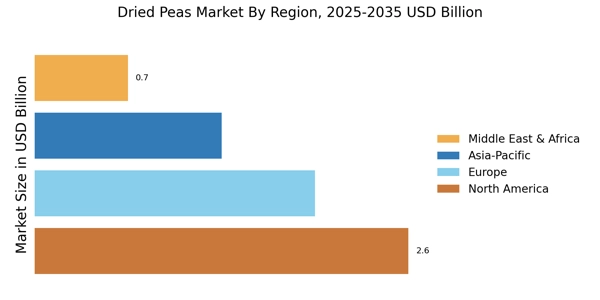Innovative Product Development
Innovation plays a crucial role in the Dried Peas Market, as manufacturers explore new product formats and applications to meet evolving consumer preferences. The introduction of ready-to-eat meals, snacks, and flour derived from dried peas has expanded the market's reach. Recent data suggests that the demand for pea protein isolate is on the rise, with a projected growth rate of around 15% in the next few years. This innovation is driven by the increasing popularity of plant-based diets and the need for convenient, nutritious options. Additionally, the versatility of dried peas allows for their incorporation into various culinary applications, from soups to baked goods. As companies continue to invest in research and development, the Dried Peas Market is expected to witness a wave of innovative products that cater to diverse consumer needs.
Expansion of Distribution Channels
The Dried Peas Market is witnessing an expansion of distribution channels, which is facilitating greater accessibility for consumers. The rise of e-commerce platforms and online grocery shopping has transformed the way consumers purchase dried peas, allowing for a wider reach beyond traditional retail outlets. Recent statistics indicate that online grocery sales have increased significantly, with a notable portion attributed to health foods, including dried peas. This shift in purchasing behavior is likely to continue, as consumers increasingly prefer the convenience of online shopping. Additionally, partnerships between manufacturers and retailers are enhancing the availability of dried peas in supermarkets and specialty health food stores. As distribution channels expand, the Dried Peas Market is poised for growth, catering to a diverse consumer base seeking nutritious and convenient food options.
Rising Demand for Plant-Based Proteins
The Dried Peas Market is experiencing a notable surge in demand for plant-based proteins, driven by a growing consumer preference for vegetarian and vegan diets. This shift is largely influenced by health consciousness, as individuals increasingly seek alternatives to animal proteins. According to recent data, the plant-based protein segment is projected to grow at a compound annual growth rate of approximately 10% over the next five years. Dried peas, being rich in protein and essential nutrients, are well-positioned to capitalize on this trend. The increasing awareness of the health benefits associated with legumes, including improved digestion and heart health, further propels the demand for dried peas. As consumers become more informed about their dietary choices, the Dried Peas Market is likely to see sustained growth in this segment.
Growing Awareness of Nutritional Benefits
The Dried Peas Market is benefiting from a heightened awareness of the nutritional advantages associated with dried peas. These legumes are recognized for their high protein content, fiber, and essential vitamins and minerals, making them an attractive option for health-conscious consumers. Recent nutritional studies have highlighted the role of dried peas in promoting heart health and managing blood sugar levels, which resonates with a broad audience. As more consumers seek to enhance their diets with nutrient-dense foods, the demand for dried peas is likely to increase. Furthermore, educational campaigns by health organizations and food manufacturers are contributing to this awareness, thereby driving growth in the Dried Peas Market. This trend suggests a promising future for dried peas as a staple in health-oriented diets.
Sustainability and Environmental Concerns
Sustainability has emerged as a pivotal driver within the Dried Peas Market, as consumers and manufacturers alike prioritize environmentally friendly practices. The cultivation of dried peas is generally associated with lower carbon emissions and reduced water usage compared to other crops. This aligns with the increasing consumer demand for sustainable food sources, which is reflected in market trends. Recent studies indicate that legumes, including dried peas, contribute to soil health through nitrogen fixation, making them a sustainable choice for crop rotation. As environmental awareness continues to rise, the Dried Peas Market is likely to benefit from a shift towards sustainable agricultural practices. This trend not only appeals to eco-conscious consumers but also encourages food manufacturers to incorporate dried peas into their product lines, thereby enhancing market growth.


















Leave a Comment